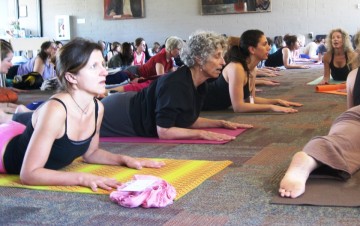
Whether the class you have enrolled in is called LifeForce Yoga, White Lotus, Bikram, Iyengar, Viniyoga, Ashtanga, Kripalu, Integral, Sivananda, Svaroopa, Jivamukti, Anusara, or any of the many schools of Yoga, you are practicing Hatha Yoga, and you are already choosing positive mental health. Your decision to practice Yoga emerges from your own reservoir of mental health—your own inner wisdom—particularly if, in this moment, you are suffering. Take a moment to honor and acknowledge yourself.
The many types of Yoga mentioned above are all forms of Hatha Yoga. The word Hatha literally means physical force. Hatha Yoga is a practical physical system for aligning body, mind and spirit, enhancing a sense of well being and managing and perhaps even eradicating your depression. While it is a system practiced by some but not all Hindus, Jews, Christians, Moslems, atheists and agnostics also practice it. A young woman I know, who is a religious Jew, understands the importance of aligning and relaxing her body and mind and organizes Yoga classes with other Orthodox women.
No matter what form of Hatha Yoga practice you try, consider these four important principles:
- Breathe! Unless instructed otherwise by a qualified Yoga teacher, always breathe deeply and slowly through the nostrils while entering, holding and releasing a pose. The postures themselves are not magic positions; it is your breathing that gives them the power to heal. In some cases, if you’re not breathing deeply and slowly, it is even possible to make your situation worse. Sally, a Rhode Island Yoga teacher, says that back in the 70’s when she first took Yoga classes, her teacher did not talk about the breath, resulting, she believes, in the exacerbation of a misaligned rotation in her hipbone that has caused compression in her sacrum since birth. While Sally’s lifelong tendency toward depression is endogenous, which means it has no known origin, she believes it is the compression in her sacrum that may be responsible for her depressive symptoms. If you are not conscious of your breathing in your Yoga practice, the practice may not help you manage or eliminate your depression. In fact, it might, as Sally believes happened to her, make it worse.
- Listen to Your Body Let your body be your first teacher. If you are paying attention to the sensations you feel as you practice, you will know when to release a pose or modify it. Yoga is not a competitive sport. Practicing with others in a class does not make you a member of a synchronized Yoga team. You are an individual with a different body, a different set of life experiences, injuries and abilities than the twenty-something or the sixty-something practicing next to you. You can hurt yourself in Yoga if you push or strain or forget to breathe. Relax into the pose by breathing deeply, using little micro-movements to move in and out of your body’s full expression of the pose. Listen to the sensations you feel and moderate your pose to accommodate them. This Attention to sensation in your body helps you develop mindfulness and an observing mind, on and off the mat. This helps you understand how much more you are than the constriction of the particular mood or mind state (anxiety, depression, worry, shame, anger, etc.) that was present before you began your yoga practice.
- Sequence your poses Each pose you practice has a stimulating or soothing effect on the chakras and the glands in your body. For example, the thymus gland is stimulated in backbending poses, which strengthens your immune system. It’s important to practice a sequence that balances the energy in the chakras and glands. This means following a basic routine established by a qualified Yoga teacher. Unless contraindicated because of a medical condition from which you suffer, your Yoga session should include forward bends, back bends, side-stretching, twists and inversions.A general guideline is to meet your mood. If your mood is lethargic or depressed, begin slowly, perhaps with restorative poses and deep breathing. Then as the breath begins to awaken your energy, move to a more vigorous standing practice. Be sure to include a backbend or two, at your level of practice. On the other hand, if you are feeling revved up and anxious, burn off some of that anxiety with sun salutations or pranayama. Then, when you are feeling more centered, begin to slow your practice down, ending with forward bending poses and relaxation.
- Learn the locks from a qualified teacher The locks (bandhas) are three internal lifts that make your practice of postures and pranayamas more powerful and should be learned from and practiced with a qualified teacher, not from a book. On the other hand, they are so intrinsic to Yoga that you may find your body naturally lifting up internally as you practice. You may find that in certain standing poses you are naturally drawn to lift the pelvic floor. This is a simulation of the root lock (mula bandha), and it protects the lower back, particularly in backbends. It also gives you strength in standing postures. You will find that the abdomen naturally draws back toward the spine in certain postures, particularly forward bends and in some breathing exercises. This motion simulates the stomach lock (uddiyana bandha). Uddiyana literally means, “to fly up.” When you draw the abdominal organs up and in, you are creating a natural upward flow of energy. In other postures like shoulder stand and forward bending head to knee pose, your chest will naturally lift to meet your chin. This simulates the throat lock (jalandhara bandha), and it compresses and stimulates the thyroid gland. When the locks occur spontaneously in a pose, don’t resist them. But do not consciously practice them without first receiving guidance from a qualified Yoga teacher.
You can practice LifeForce Yoga with me on my Level 1 DVD.
To Find a LifeForce Yoga Practitioner in your area, click here.
This article was adapted from Chapter Five in Yoga for Depression (Broadway Books). To read the book, click here.

Very succinct explanations and directions for beginning students. I would appreciate if you would email this information to me so I can share it with a very good friend in California who I’m encouraging to take up Yoga and make it a regular practice. Please put me on your mailing list for future articles you’re sharing with the public. Thank you so much. Namaste, Tina Spencer, SooNipi Yoga